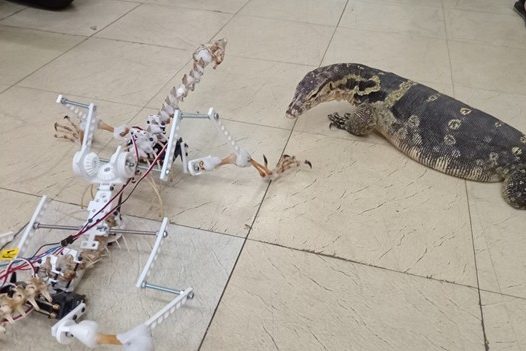
Robots, combined with microcontroller components and sensors, are typically made from steel, aluminum, rubber, plastic, or cardboard.
However, in this case, a team from the UGM Faculty of Biology and the University of Edinburgh created a robot using the real skeleton of a monitor lizard.
This collaboration resulted in a necrobot monitor lizard capable of simple movements, serving as a learning tool in animal systematics.
This technology integrates science and engineering through cooperation between the two universities.
Dr. Eko Agus Suyono, a lecturer at Biology UGM, and Dr. Parvez Alam, a lecturer at the University of Edinburgh, initiated the research in September last year.
The idea began when Dr. Alam invited Leo Foulds and Nadia Ditta, two of his master’s degree students from the School of Engineering at the University of Edinburgh, to come and work at the Animal Systematics Laboratory, Biology UGM, to study reptile skeletons, particularly those of monitor lizards and snakes.
“At that time, Biology lecturer Donan Satria Yudha provided information on the movement, taxonomy, and anatomy of reptiles in Indonesia,” Dr. Suyono explained in a statement to reporters on Friday (Feb. 7).
He said that during the first two weeks, the two teams divided tasks, with Dr. Alam recording the movements of live adult monitor lizards while walking.
Then, both teams studied the mechanics of the monitor lizard’s bones and performed a CT scan of the skeleton to create a mold of it.
“This skeleton mold would later be fitted with the robot machinery upon returning to Edinburgh,” he added.
In mid-January 2025, Dr. Alam contacted Dr. Suyono and Yudha to share a video showing the mold of the monitor lizard skeleton walking after being equipped with necrobot machinery.
At the end of January 2025, Alam returned to the Faculty of Biology UGM to install the robot machinery onto the actual monitor lizard skeleton.
“During the assembly of the robot machinery onto the monitor lizard skeleton, Yudha was assisted by Frans from the Museum of Biology and several students,” Dr. Suyono said.

The assembly process involved Yudha, a lecturer from the Animal Systematics Laboratory, working with FX Sugiyo Pranoto from the UGM Museum of Biology, and several students, including Rashif Naufal Andika, Ananto Puradi Nainggolan, Maula Haqul Dafa, Arkanniti Dibyawedha Adisajjana, and Afif Fatah Rizki.
Assembling the robot machinery onto the actual monitor lizard skeleton, according to Dr. Suyono, was not easy.
Dr. Alam completed it in three days, successfully creating a necrobot monitor lizard capable of simple movements.
This result was very satisfying, considering the materials, composition, and structure differences between the mold and the actual bones.
Dr. Alam later donated the necrobot monitor lizard to the Animal Systematics Laboratory, Biology UGM, as a new learning tool for lecturers and students.
“For the Faculty of Biology, the process of studying and assembling necrobots from a monitor lizard skeleton provides new knowledge,” he concluded.
Author: Jelita Agustine
Editor: Gusti Grehenson
Post-editor: Afifudin Baliya

